The Navy’s Deadly Obsession with Whales
The true, tragic, and improbable love story between a handful of Navy scientists and the small cetaceans they believed held the keys to mastery of the oceans.
New perk: Easily find new routes and hidden gems, upcoming running events, and more near you. Your weekly Local Running Newsletter has everything you need to lace up! .
You've likely read the stories—or at least heard rumors—about America’s secret dolphin navy, trained to patrol harbors and clear mines. Or perhaps you’ve followed the lawsuits, filed by the Natural Resources Defense Council, against the U.S. Navy over whale strandings, one of which made its way to the U.S. Supreme Court in 2008.
But there's a tragic and ironic backstory to these events that's remained hidden behind veils of classified reports, official denials (plausible and otherwise), and improbably scientific history.
It's a tale of obsession. A failed marriage between Navy scientists and small cetaceans with a genius for biosonar, or echolocation, that whales and dolphins evolved over tens of millions of years—and which the U.S. Navy hoped to reverse-engineer in an effort to perfect its mine-sweeping and anti-submarine warfare.
It's an unlikely tale of science gone awry in a 20-year battle between conservationists and the U.S. Navy over whale strandings, which I explore in my new book . And it all began in the basement of a biology lab at Harvard University during WW II…
By the end of 1945, it had become clear to everyone in the whaling industry that 50 years of unbridled slaughter had decimated whale populations around the world. Many commercial species were already depleted and threatened with extinction. Throughout the first half of the 20th century, fleets of floating factory ships had been killing and processing whales at sea with lethal efficiency. Throughout the 1920 and 1930s, tens of thousands of great whales were harvested each year. In 1939 alone, whalers killed almost 40,000 blue whales.
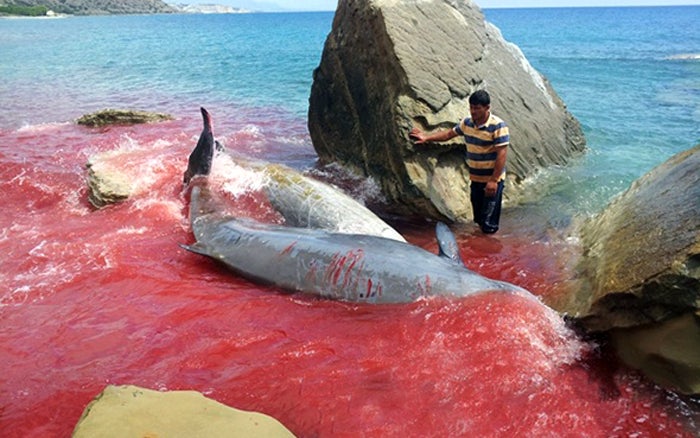
Whaling was suspended during World War II, as shipping lanes shut down and many whaling ships were drafted into service as military cargo vessels. Still, the war took a deadly toll on whales caught in the cross fire of major sea battles in the Atlantic and Pacific. Millions of tons of explosives were detonated in the oceans, including hundreds of thousands of antisubmarine depth charges. Air Forces and navies on both sides of the conflict made a practice of using passing pods for target practice. In the aftermath of the war, industrious whalers adapted military sonar to locate, drive to the surface, and herd their prey—but there were indisputably far fewer whales left to hunt.

In 1946, 15 whaling nations established the with the stated goal “to provide for the proper conservation of whale stocks and thus make possible the orderly development of the whaling industry.” The idea of preserving whale populations for purposes other than killing and processing them into margarine and motor oil was still 20 years in the future. And it would be fully 40 years before the International Whaling Commission called a halt to commercial whaling worldwide in 1986.
During those intervening four decades, whales would undergo a radical cultural transformation from commercial commodity to entertainment superstars and revered icons of the new Age, environmental, and animal rights movements. Where once their value was measured in the price per barrel of their oil, whales and dolphins would suddenly become box-office sensations, drawing millions of admiring customers to movie theaters, aquariums, and theme parks, and, in time, to open-sea whale-watching venues around the world.
One of the unlikely catalysts of this cultural sea change was the cadre of scientific researchers—almost all of them funded by the U.S. Navy—who first studied and appreciated whales as more than mere casks of oil. What they discovered was that dolphins and other small cetaceans had evolved, over tens of millions of years, to master sound as a means of navigating and hunting in the dark ocean depths.
Locating dangerous objects in the opaque oceans—whether enemy submarines, swimmers or sea mines—was the Navy’s most pressing challenge. So when Navy researchers discovered dolphins’ genius for hunting and navigating in the dark ocean, they pounced on the chance to decode and deploy their advanced biotechnology to military advantage.
The impetus for the was a bat-obsessed biology student named Donald Griffin. In 1940, while still an undergraduate at Harvard, Griffin conceived an experiment to solve a 200-year-old zoology puzzle known as “Spallanzani’s bat problem.” Lazzaro Spallanzani had been an eighteenth-century Italian naturalist who hypothesized, after alternately blinding and deafening bats, that they navigated in the dark using sound rather than sight. But because bats transmitted their high-frequency sound signals above the human hearing threshold, they appeared to be flying in silence. This conundrum left Spallanzani unable to explain precisely how bats navigate in pitch-black caves.
When Griffin learned that Harvard’s physics department had recently invented an ultrasonic sound detector, he hoped this new technology might be the key to unlocking Spallanzani’s “problem.” He constructed an elaborate maze of hanging wires in a blacked-out basement laboratory, which he then equipped with ultrasonic sound receivers. The bats successfully navigated the maze in total darkness, and the ultrasonic receivers enabled Griffin to record the squeaky clicks of their ultrahigh-frequency sound emissions. He deduced correctly that the bats were navigating by the echoes from their clicks, a method that he named “echolocation.” Griffin later demonstrated that bats also employed echolocation to hunt in the dark, using different frequency transmissions depending on the size of the insects they were hunting.
The Navy, always on the lookout for ways to improve its radar and sonar capabilities, immediately took an interest in Griffin’s findings. After the (ONR) began supporting his research into animal behavior, Griffin speculated that mammals other than bats might navigate by echolocation—notably, whales in the lightless ocean depths. This provocative supposition encouraged the Navy—in service to its antisubmarine warfare mission—to embark on a decades-long effort to confirm, describe, decode, and deploy cetacean biosonar.
There was nothing novel about the idea of recruiting animals into warfare. Elephants, camels, and horses had conveyed soldiers, supplies, and arms into battles for centuries. Soldiers had long trained dogs to attack enemies, sniff out bombs, guard facilities, and, in the case of the Soviet army in World War II, to run under enemy tanks with explosives strapped to their backs.
During the same war, the British Air ministry Pigeon Section deployed a quarter million homing pigeons as military messengers—32 of which were awarded the Dickin medal “for conspicuous gallantry and devotion to service.” Not to be outdone by its ally across the Atlantic, the U.S. military developed the Bat Bomb Project, a novel plan for deploying bats in combat.
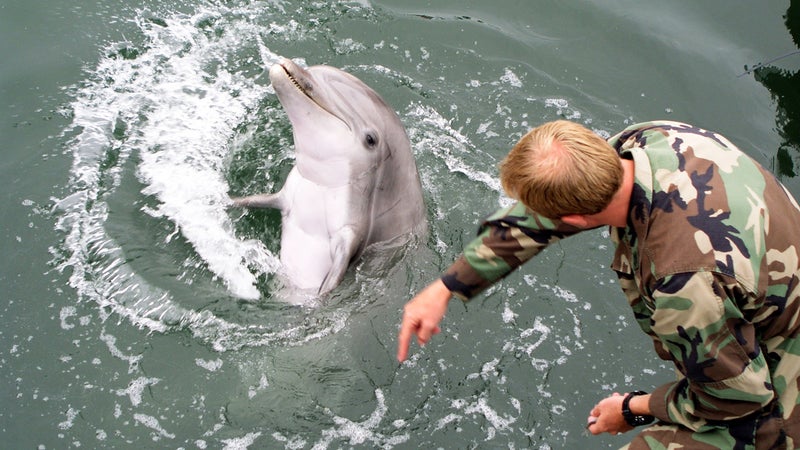
Working inside Harvard’s psychoacoustics lab, Griffin was assigned to the Bat Bomb Project, the brainchild of a dental surgeon and bat enthusiast named Lytle Adams. After the attack on Pearl Harbor, Adams sold the War Department on his idea of surgically implanting incendiary devices into the chests of thousands of bats, and then releasing them from planes over Japanese cities. Adams theorized that the bats would nest under the eaves of the wooden houses that dominated Japanese cities. When their time-delayed fuses expired, the bats—and the buildings—would explode into flames. The War Department built a mock Japanese village in the dessert outside Carlsbad, New Mexico, to war-game the bat bomb. Once unleashed, the planeload of incendiary bats burned the wooden village to the ground, but a few errant bats managed to also incinerate a nearby military research facility. The War Department decided to abandon bat bombs in favor of the conventional incendiary bombs it dropped from B-29s over Tokyo and dozens of other Japanese cities in 1945.
Meanwhile, on the European front, the Navy was trying to enlist pigeons into its bombing campaigns. Another Harvard-educated researcher, behaviorist B. F. Skinner, conceived Project Pigeon to improve the guidance system of missiles targeting German battleships. Skinner placed operant-conditioned pigeons inside the nosecone and trained them to steer the missile to its target by pecking on a projected image of the battleship. Despite an effective demonstration, Skinner couldn’t convince the Navy brass to trust pigeons to guide their missiles, and Project Pigeon was aborted in 1944.
But Griffin’s discovery of animal echolocation transformed the quest to harness an animal’s unique sensory talents for military advantage. Instead of merely training animals to fight, Griffin inspired naval engineers to renew a centuries-old tradition of looking to biology for design inspiration. Leonardo da Vinci modeled ship hulls on the fish and marine mammals he illustrated. The Wright Brothers adopted a fixed-wing design for their first airplane after observing that large birds glided with almost no wing movement. In the 1950s, engineers called animal-inspired technology biomimetics and biomimicry, derived from the Greek bios, for “life,” and mimesis, for “imitation.” However, it was the term “bionics,” the compound of “biology” and “electronics,” that the Navy adopted to describe its research and development of technology that could rival the biosonar talents of a dolphin.
Before the U.S. Navy became the leading patron of modern cetology, whale science had relied primarily on whalers’ observations of the behavior of their prey. The only research expeditions of any note had been the Discovery investigations in the 1920s and 1930s, led by British scientists who culled anatomical specimens from the decks of whaling ships working the waters near Antarctica.
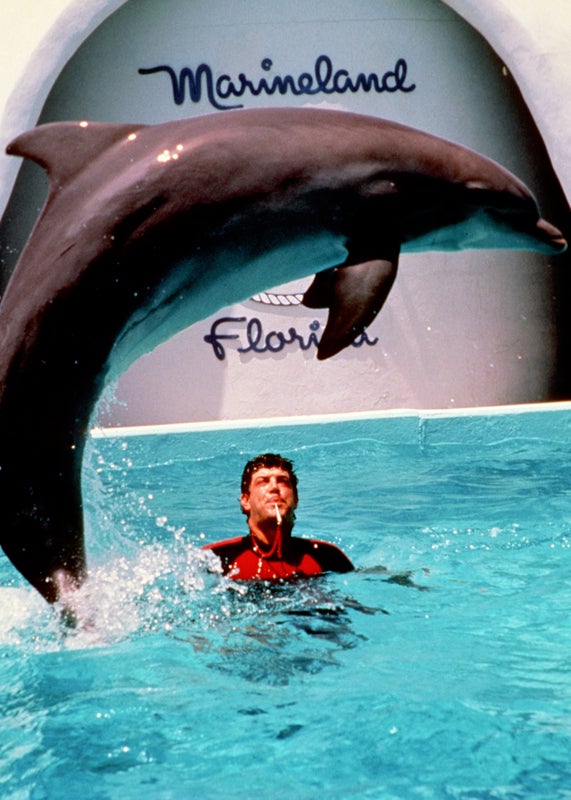
The Navy chose a tamer setting to test Griffin’s hypothesis of cetacean biosonar. Marine Studios, originally built in the 1930s as a film set for underwater movies, was stocked with dolphins, seals, and sharks captured from the waters near St. Augustine, Florida. After closing during the war, it reopened as , the nation’s first marine park.
Marineland’s live shows starring trained dolphins gave tens of thousands of visitors their first close-up view of small whales. Just a decade earlier, dolphins had been despised by fishermen who derided them as “pig fish” and “herring hogs” for poaching fish from their nets. But with the rising celebrity of Flippy, Splash, and Zippy—whose balletic performances were broadcast live on CBS-TV’s Marineland Carnival—dolphins began a long run as America’s marine mammal sweethearts.
A marine park turned out to be a good laboratory for conducting dolphin research. Man-made tanks bore little resemblance to a dolphin’s natural habitat, but compared to the dark oceans, they offered early investigators a transparent and controlled research environment. Dolphins, highly social and responsive to training, could provide direct feedback to stimuli much the way that a human subject could, pressing levers in response to commands and even vocalizing. Navy-funded studies at Marineland marked cetology’s transition from a “dead science,” based on examination of scavenged remains from beaches and whaling stations, to a “life science” of controlled experimentation and observation, first in captive settings and later in the wild.
The young biologist-psychologist who served as the curator of Marineland, Arthur McBride, became fascinated by the extraordinary range of sounds emerging from the dolphin tanks. Aristotle had recorded his observations of dolphin vocalizations thousands of years earlier in his Historia Animalium, but McBride was the first scientist to remark on the biosonar possibilities of their barks, grunts, clicks, whistles, moans, and distinctive “creaking door” sound. having heard from local fishermen about the dolphins’ ability to evade their nets in Florida’s opaque St. John’s river, McBride noted in his journals that “this behavior calls to mind the sonic sending and receiving apparatus which enables the bat to avoid obstacles in the dark.” In 1947, with the aid of “a supersonic sending and receiving apparatus” provided by the newly formed office of naval research, McBride began to measure dolphin responses to ultrasonic frequencies.
In 1951 ONR dispatched William Schevill and his research partner and wife, Barbara Lawrence, from to Marineland to test Griffin’s and McBride’s hypothesis of dolphin echolocation. After recording the full range of dolphin vocalizations and verifying the acuity of their hearing, Schevill and Lawrence transported one of the animals back to Woods Hole for further tests. Working at night in a pond, they confirmed the dolphins’ ability to navigate around nets in the dark, muddy water.
At the same time, ONR was funding research by Winthrop Kellogg, a psychologist at Florida State University. With the assistance of then undergraduate marine biologist Sylvia Earle, Kellogg established that dolphins consistently swam around a transparent Plexiglas wall, even in darkness. By 1953, Kellogg and the Schevills had independently published research demonstrating that the dolphins’ “rusty-hinge” vocalization was actually a series of rapid clicks with a wideband frequency spectrum that they used to navigate, hunt, and communicate.
Finally, Ken Norris, a World War II Navy veteran and curator of Marineland’s newly opened sister park, Marineland of the Pacific, in Southern California, conclusively proved dolphin echolocation. Norris outfitted a bottlenose dolphin named Zippy with suction cup blindfolds to demonstrate that he could navigate a maze of pipes suspended in a tank. Zippy accurately echolocated objects at a distance of 30 feet. Later research revealed that dolphin biosonar far outmatched the Navy’s active sonar technology in every dimension. Dolphins could detect a target the size of a tangerine from 300 feet away, and could distinguish between an aluminum and an iron plate, a hollow tube and a solid one, and ball bearings of microscopically different sizes. Dolphins could discriminate 5,000 individual clicks per seconds, compared to a human’s ability to detect 30 per second.
Kellogg expressed the consensus view of his research colleagues when he reported to ONR “What these animals can do has a definite bearing on our national defense, as a means of improving man-made sonar.”
The Navy’s began in 1961 as a straightforward biomimicry experiment. Dolphins had long been observed to be among the fastest swimmers in the sea, so the navy had a natural interest in studying their hydrodynamic properties, from their streamlined fuselage to the drag-reducing properties of their skin. The Naval Ordnance Test Station (NOTS) at China Lake was a dry lakebed in the Mojave Desert, 100 miles inland. But its satellite facilities on the Pacific Coast concentrated on improving torpedo propulsion, speed, and accuracy.
In 1961 NOTS purchased a female white-sided dolphin it named Knotty from Marineland of the Pacific. For the next year, until Knotty died, NOTS researchers conducted a variety of tests to measure her speed and propulsion through the water. The impact of those studies on submarine design is evident in comparisons of before-and-after diagrams of their hulls, which became markedly less boatlike and more cetacean in shape after 1962.
The research program soon expanded to include animal training. The Navy constructed a large concrete tank, affectionately known as “the porpoise pool,” just up the coast from Malibu at Mugu Lagoon. But the three white-sided dolphins it purchased from a fisherman in Santa Monica died within weeks of their arrival.
The Navy turned to Marineland in Florida for help. Marineland’s curator and head veterinarian, Forrest Wood, came aboard as director of the nascent Marine Mammal Training Program at Point Mugu. Wood brought along a new supply of dolphins, his own expertise in dolphin health care, and several trainers who had tutored animals for Marineland shows and for Hollywood movies such as Doctor Dolittle. Wood kept the Navy dolphins alive in captivity, while the animal trainers instructed him on how to train dolphins to respond to sound signals and food rewards in much the same way that guard dogs are trained.
Then, in 1967, CIA satellite surveillance discovered that the Soviets had undertaken their own dolphin research program, headquartered in an old hotel on the shore of the Black Sea. Russian science articles purloined and translated by U.S. naval intelligence documented extensive research into dolphin bioacoustics, physiology, anatomy, radiotelemetry, and hydrodynamics. Fearing an imminent “dolphin gap,” Congress ramped up funding for the Marine Mammal Training Program, shifting its focus to operational “animal systems” that could directly support naval operations.
Almost overnight, all of the Navy’s marine mammal research and operations became classified and would remain so until the end of the Cold War. The focus of the program became focused on developing the dolphins’ potential as minesweepers, deep-water object retrievers, and harbor sentries.
Enemies could easily blockade a harbor by laying mines in shallow water or tethering them to the seabed, set to detonate in response to any acoustic or magnetic impulse from an approaching ship. Another mine-laying technique was to litter a harbor with dozens of decoy mines interspersed with a few live ones. It would take a conventional minesweeping crew days to distinguish the live mines from the decoys.
To test dolphin proficiency in identifying sea mines, Navy trainers planted 48 mines in Beacher’s Bay in the Channel Islands. Within two hours, one dolphin had located all 48 mines, plus five World War II–era mines that had gone astray 25 years earlier. Navy dolphins could also distinguish real mines from decoys. They could even detect mines buried under six feet of sediment on the ocean floor. After just a few weeks of training, dolphins were consistently outperforming human and mechanical minesweepers.
Because the Navy frequently lost expensive equipment and weapons in deep water, it attached acoustic “pingers” to anything of value that might go missing as a guide to divers during recovery missions. But humans are poorly equipped to retrieve objects from the deep ocean. They can’t dive deeper than a few hundred feet; they don’t tolerate the cold temperatures at depth very well; and they can work for only about twelve minutes at depth before having to surface slowly and decompress. Human divers can’t see well underwater, and they have poor directional hearing, so even with the aid of an acoustic beacon, they have trouble distinguishing the location of the sound source. Dolphins, by contrast, are perfectly engineered for the task. They can hold their breath for seven minutes and dive repeatedly to hundreds of feet with minimal decompression time at the surface between dives. Their underwater hearing is excellent, and their echolocation skills enable them to find objects hidden behind vegetation or buried in mud.
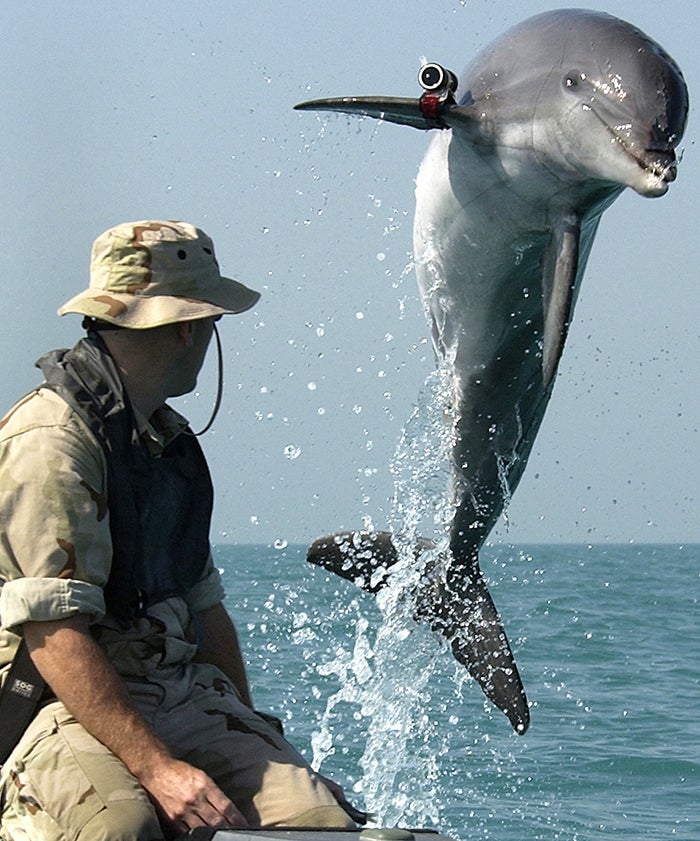
In support of “Deep Ops” and “Operation Quickfind,” the Navy trained dolphins and sea lions to first locate lost equipment on the ocean floor, and then attach lift lines or self-inflating lift bags to bring the objects to the surface. Historically, recovering torpedoes meant dispatching teams of Navy divers, recompression vans, and medical personnel. The Navy was able to train its marine mammals to recover torpedoes lost at depths of up to eight hundred feet.
In 1969, North Vietnamese frogmen were infiltrating the port at Cam Ranh Bay and attaching explosives to the sides of American ships. As a countermeasure, the Navy trained the Point Mugu dolphins for “swimmer interdiction.”
Equipped with a snorkel and a rebreather, a Navy trainer played the enemy swimmer trying to penetrate Mugu Lagoon without being detected by the bottlenose sentries. Once he’d trained the dolphins to ram intruding swimmers with their snouts, the trainer never made it anywhere close to the beach before being intercepted. Several cracked ribs later, he flew eight of the bottlenoses and one pilot whale to Hawaii aboard a specially equipped cargo plane, and then on to Guam for final operational training.
In early 1970 the five best-performing guard dolphins arrived at Cam Ranh Bay. The Navy anchored three catamarans with netted dolphin pens hanging between the pontoons across the mouth of the wide bay at 9:00, 12:00, and 3:00. The dolphins were trained to continuously scan their sector of the bay and to press a black or white paddle with their snouts every two minutes: white for “all clear,” black for “swimmer in the water.” When a dolphin pressed the black paddle, the door to the pen would open and release the animal into the bay.
Before leaving the pen, the dolphin would press its snout into a custom-fitted fiberglass nose cone armed with a barbed steel hook that protruded from the front. The dolphin was trained to quickly track down the swimmer, stab him in the buttocks or the upper thigh with the barbed hook, pull out of the nose cone, and return to its pen. The nose cone was designed to rapidly inflate and jettison the swimmer to the surface, where Navy SEALs in high-powered black speedboats would swoop in for the capture. The swimmer saboteurs, drawn from the ranks of North Vietnamese army officers, were considered high-value interrogation subjects.
The system worked flawlessly for the first few interdictions—until the swimmers began carrying hand grenades and tossing them into the approaching speedboats. The SEALs eventually designed countermeasures to prevent grenade attacks, and, after losing several highly trained saboteurs to the dolphin/SEAL patrols, North Vietnam stopped sending swimmers into Cam Ranh Bay.
By the 1970s, the Navy was working to reverse engineer dolphin echolocation to improve existing sonar technology. After the United States withdrew from Vietnam in 1973, the focus of the Navy’s marine mammal research shifted from “What can they do?” to “How can we build technology to replicate what they do?” Dolphins consistently outperformed human divers and existing sonar technology for guarding harbors and detecting mines. But dolphin crews were expensive to maintain and difficult to transport around the world. So, the Navy hoped it could gradually replace its high-maintenance dolphins with bionic drones.

But the more they learned about dolphin biosonar, the more daunting their bionic design challenge appeared. Dolphins could collect, assimilate, and interpret an astounding amount of data, and they could do it amid the acoustic complexity of the open ocean. And dolphin signal processing exceeded anything that computers could replicate in the 1970s.
Research into dolphin hunting behavior in the wild offered tantalizing clues for designing the kind of short-range, high-frequency sonar systems that might someday replace the Navy’s dolphins as minesweepers and harbor sentries. Dolphin biosonar operates in a highly mobile and adaptive fashion, with decisions about next actions flowing out of real-time assessment of streaming information. When the Navy searched the sea, it ran a grid in straight lines on a regimented schedule. But a dolphin continues to adjust its swimming pattern and sonar algorithm as it goes, circling an unknown object, scanning it from different angles to create a three-dimensional model, sorting relevant data from extraneous data, and, finally, extrapolating historical data points to arrive at accurate judgments about a target: is this fish going to taste good or make me sick? Is this an armed mine, or a decoy?
Navy researchers confirmed earlier observations that dolphin sleep occurs in one brain hemisphere at a time, while the other hemisphere continues to scan the environment for data—in much the same way that an antivirus program continues to scan a hard drive even when the drive is “sleeping.” In fact, one of the Navy’s Hawaii-based biosonar researchers, an experimental psychologist named Herb Roitblat, translated the neural networks of dolphin colonies into a new kind of internet search engine. He left the Navy, patented his invention, and built a startup around his algorithm, which he called DolphinSearch. However, duplicating the dolphin’s continuous learning cycle required a level of artificial intelligence design that lay decades in the Navy’s future.
Another avenue of biomimicry research examined the group-learning dimension of dolphin biosonar—what today would be called “crowdsourced intelligence.” As herd animals, dolphins in the wild are constantly pooling and exchanging their search data. The closest analogy would be the modern internet search engine, which scans oceans of data using specific terms, tags, and criteria, while simultaneously incorporating a steady stream of user search requests, past and present.
In the 1980s, the Navy moved closer to deploying its dolphin drones, which it called Autonomous Underwater Vehicles, or AUVs. They looked like dolphins in size and shape, and were equipped with multibeam sidescan sonar that approximated dolphin biosonar. But the AUV had a gaping hole in its motherboard where a real dolphin’s “wet brain” lives and works. After a quarter century of close observation, Navy researchers had learned a lot about the dolphin’s physical and neural anatomy but very little about its mind and how it made judgments.
Despite the early confidence of naval engineers that they could manufacture a bionic dolphin, the “advanced biologicals,” as the Navy referred to its marine mammal recruits, had been evolving their biosonar for 30 million years—too big a head start, it appeared, to overcome in just a few decades.
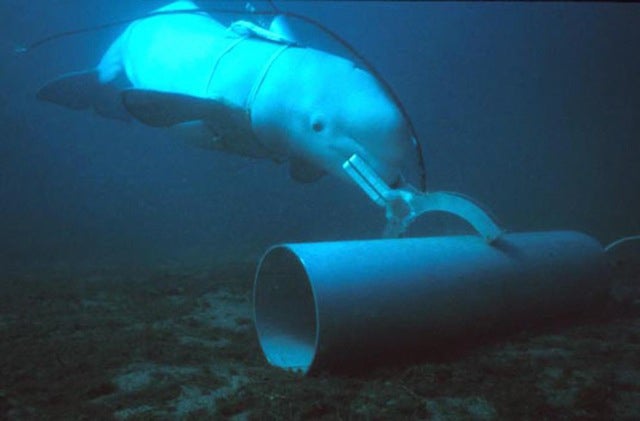
In 1986, the Navy persuaded Congress to amend the to allow the Navy to collect dolphins in the wild for unspecified “national defense purposes.” The Navy’s marine mammal menagerie swelled to more than 100 dolphins, dozens of sea lions, and a supporting cast of beluga whales recruited for deep dives in Arctic waters.
In 1987, for the first time since the Vietnam War, the Navy redeployed dolphins as seagoing sentries—this time in the Persian Gulf. When Iran began mining the harbor in Bahrain to disrupt oil tanker traffic, the Navy dispatched six dolphins to clear mines, protect U.S. warships against enemy swimmers, and escort Kuwaiti tankers in and out of the harbor. Many of the dolphins couldn’t handle the sudden transition from the cold water of San Diego to the extreme warmth of the Gulf. One named Skippy died of a bacterial infection. The Marine Mammal Program was still classified at the time, but news of the dolphin deployment in the Persian Gulf leaked to the media.
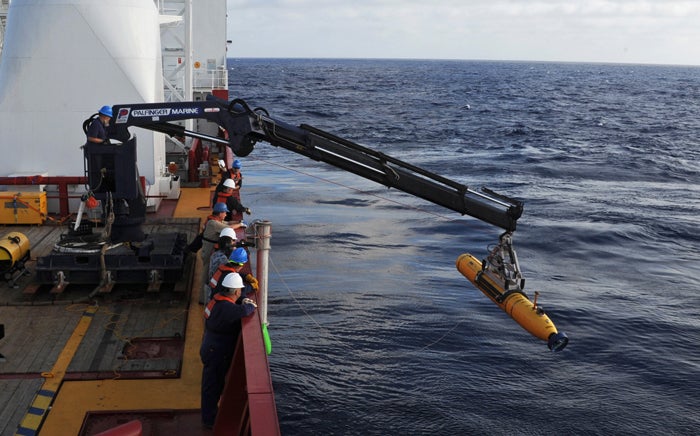
When the New York Times and other outlets that the Navy was endangering dolphins to protect Arab oil tankers, the animal rights movement mobilized in protest. A year later, the Navy proposed deploying dolphins to guard the trident missile submarine base at Bangor, Washington. When animal advocates sued the Navy over the health risks of moving the San Diego–based dolphins to cold northern waters, a judge ordered the Navy to study the issue, and the Navy abandoned the project.
After the outbreak of the second Gulf War, the Navy deployed its Autonomous Underwater Vehicles (AUVs) for mine-clearing operations in the Persian Gulf. But the AUVs worked only where the sea floor was sandy and flat. In more complex environments, they proved unreliable. Without a fully functional dolphin drone, and with new underwater enemies to combat, the Navy turned once again to its “porpoise pool” for help.
Excerpted from Joshua Horwitz's book, (Simon & Schuster), out now.


